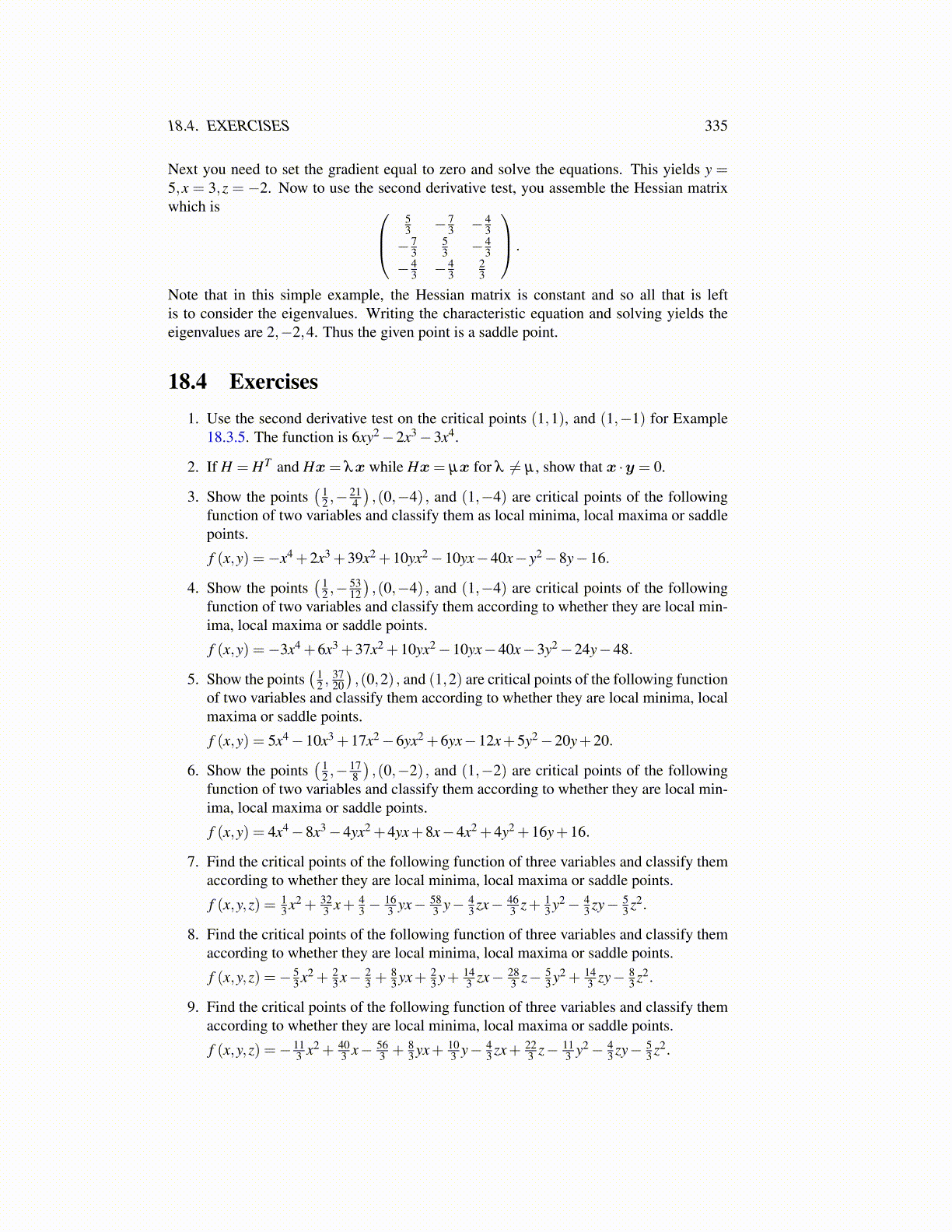
18.4. EXERCISES 335
Next you need to set the gradient equal to zero and solve the equations. This yields y =5,x = 3,z = −2. Now to use the second derivative test, you assemble the Hessian matrixwhich is
53 − 7
3 − 43
− 73
53 − 4
3− 4
3 − 43
23
.
Note that in this simple example, the Hessian matrix is constant and so all that is leftis to consider the eigenvalues. Writing the characteristic equation and solving yields theeigenvalues are 2,−2,4. Thus the given point is a saddle point.
18.4 Exercises1. Use the second derivative test on the critical points (1,1), and (1,−1) for Example
18.3.5. The function is 6xy2−2x3−3x4.
2. If H = HT and Hx= λx while Hx= µx for λ ̸= µ , show that x ·y = 0.
3. Show the points( 1
2 ,−214
),(0,−4) , and (1,−4) are critical points of the following
function of two variables and classify them as local minima, local maxima or saddlepoints.
f (x,y) =−x4 +2x3 +39x2 +10yx2−10yx−40x− y2−8y−16.
4. Show the points( 1
2 ,−5312
),(0,−4) , and (1,−4) are critical points of the following
function of two variables and classify them according to whether they are local min-ima, local maxima or saddle points.
f (x,y) =−3x4 +6x3 +37x2 +10yx2−10yx−40x−3y2−24y−48.
5. Show the points( 1
2 ,3720
),(0,2) , and (1,2) are critical points of the following function
of two variables and classify them according to whether they are local minima, localmaxima or saddle points.
f (x,y) = 5x4−10x3 +17x2−6yx2 +6yx−12x+5y2−20y+20.
6. Show the points( 1
2 ,−178
),(0,−2) , and (1,−2) are critical points of the following
function of two variables and classify them according to whether they are local min-ima, local maxima or saddle points.
f (x,y) = 4x4−8x3−4yx2 +4yx+8x−4x2 +4y2 +16y+16.
7. Find the critical points of the following function of three variables and classify themaccording to whether they are local minima, local maxima or saddle points.
f (x,y,z) = 13 x2 + 32
3 x+ 43 −
163 yx− 58
3 y− 43 zx− 46
3 z+ 13 y2− 4
3 zy− 53 z2.
8. Find the critical points of the following function of three variables and classify themaccording to whether they are local minima, local maxima or saddle points.
f (x,y,z) =− 53 x2 + 2
3 x− 23 +
83 yx+ 2
3 y+ 143 zx− 28
3 z− 53 y2 + 14
3 zy− 83 z2.
9. Find the critical points of the following function of three variables and classify themaccording to whether they are local minima, local maxima or saddle points.
f (x,y,z) =− 113 x2 + 40
3 x− 563 + 8
3 yx+ 103 y− 4
3 zx+ 223 z− 11
3 y2− 43 zy− 5
3 z2.